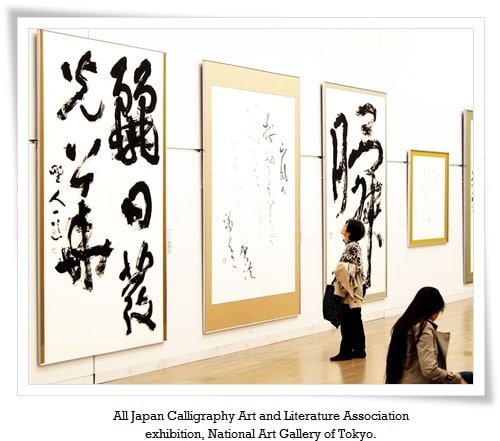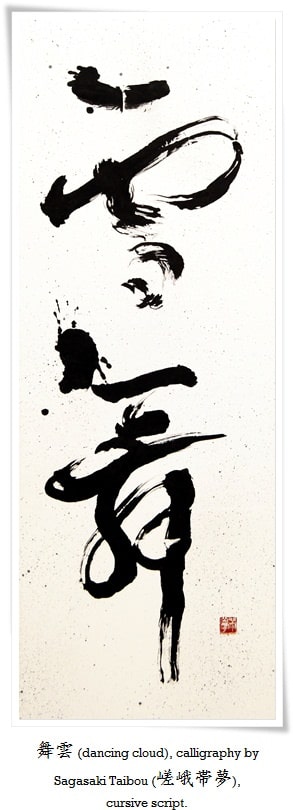The commonly-known word “calligraphy” has Greek etymology, and it derives from κάλλος kallos “beauty” + γραφή graphẽ “writing”. However, in a way, this is a very unfortunate translation in regards to calligraphy based on the Chinese writing system (on this site, also referred to as kanji, 漢字 – i.e characters from China’s Han dynasty). The difference between the Western and Eastern arts of writing is as significant as that between the Earth and the Sun, and yet the historical and theoretical information available, be it in books or on various websites, is somewhat misleading or mistaken. For this reason Chinese or Japanese calligraphy is misunderstood and its fascinating secrets remain hidden for those who have no access to texts written in kanji.
Far Eastern calligraphy is an art within art, a way of life, and a path to immortality. Just like love fills the heart, calligraphy fills our souls, nourishing a new sense of life born out of selflessness, absence of pride in the fertile soil of a pure mind. We believe that through this website we can not only share our passion, but also intrigue you by stimulating the deepest layers of sensitivity accessible to a human being.
Calligraphy in Japanese is read: shodo (書道i.e. a way of writing), when in Chinese it is shufa (書法, i.e. method of writing). The word shodo, or “sho” consists of two characters; 書 (to write) and 道 (a path), thus it would suggest that calligraphy is a way of being through writing, a path that one chooses not as an art or endeavour, but a sense of being. Sho matures with us, becoming fuller and richer. Life experience adds a lot of flavour to one’s work. In this capacity, sho cannot be learned, and it ought to be experienced, it cannot be rushed, but it must be earned.
Calligraphy is based in a logographic writing system (i.e. kanji, which are also referred to as sinographs), and in the case of Japanese calligraphy also on syllabaries (currently there are two: hiragana and katakana, although historically there were more). There is also one exceptional syllabary in the Chinese language called nushu (女書, lit. “women’s writing”), although it is not applied in classical calligraphy. However, due to its unique character, nushu is discussed in the calligraphy styles menu.
Unlike its western counterparts, a single character (kanji) can depict a word, phrase, scene, mood, and also be a poem and a painting all in one. This cannot possibly be achieved through the Latin alphabet or even painting. For instance, a Japanese phrase “matsukaze” (松風), composed of only two characters “pine” (松) and “wind” (風), yet it will translate into: “the sound of the wind roaming through pine tree tops”. Watching the maze of spiritually enchanted black lines, you suddenly feel the fresh breeze, and hear the hum of the air rubbing against the green needle leaves. Admiring expressive work full of vigour and passion is a truly hypnotizing experience.
The western art of visual writing (known as “calligraphy”, i.e. the art of beautiful writing) is more of a craft, where sho is often referred to as “heart imagery” or “soul painting”. It conveys emotions, passion, and the vision of the creator. Executed in single strokes that cannot be retouched, thought out, or planned, it offers a journey into the depth of soul of another human being. The sensation aroused by a passionate shodo can be compared to looking deep into someone’s eyes. We like to think of it as an enchanted storytelling that charms time and space.
Shodo entraps cosmic energy flow within lines, preserving a state of mind forever. Hosting such work in your home, you seed harmony and let it emanate a positive aura of simplicity. Both admiring and writing calligraphy are commonly considered forms of meditation, proven to be the most effective way of promoting longevity, surpassing any other Oriental discipline. The majority of the calligraphy masters enjoy a long and healthy life.
Being deeply spiritual, magical and truly magnificent, black ink traces soaked deep into the simple abyss of white sheet will embrace your soul in its translucent arms of purity, giving you new insight into the surrounding word, and perhaps yourself, too. For me, personally, standing in front of inspirational sho from a skilled calligrapher is beyond exciting. It is a privilege.
Sho is a unique phenomenon of the artistic world. It’s a true wonder and it is treated with great respect here in the Far East. In China and Japan there are special shrines (惜字炉, sekijiro) for burning paper covered in characters. No one dares to throw works in the bin or ever tread on them. In Japan, calligraphers used to bury brushes in Buddhist or Shinto shrines, as if they were dear friends who had expired. Shodo is considered to be a sacred vessel of ancient knowledge, a form of ever-lasting energy able to outlast its creator – the human mind.
If you take a deep bow before it, detach yourself from the modern rush and materialistic madness, it will whisper to you, heart to heart, touching your soul with eternal beauty and epic poetry of simple black lines.
“Calligraphy, even though it requires immersing oneself in lifelong study, is not based on skill per se. It is not craftsmanship either, as it is delivered when felt, and not when asked for. Evolving through millennia of historical unrest and uncertainty, shodo has proven to be truly immortal and ethereal art.
There is no such thing as complete or absolute knowledge of calligraphy, nor is there a common way to master it. It cannot be simply defined, or generalized, nor can it be fully experienced or appreciated without elevating one’s own self above the realm of the here and now. It’s free and boundless, roaming the skies of deepest emotions of the Universe, just like an elusive mythical dragon, meandering though dreamy clouds of the cosmos. You do not catch it or touch it. You simply bounce off the petty ground of reality, and soar along, side by side. “
On pages of our website you will find an abundance of detailed information on the evolution of calligraphy which was purposely divided into Chinese and Japanese history, and it is being discussed chronologically based on the appearance of the styles and the events that assisted that appearance. We believe that it is the best way to tell the story of this most fascinating art.



